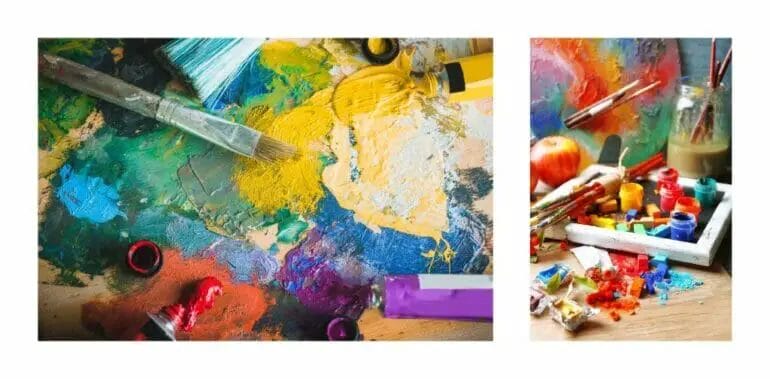Looking to transform the glossy finish of your acrylic paint into a matte one? Look no further! One incredibly simple and cost-effective solution is to use baking soda. By adding a pinch of baking soda to your acrylic paint, you can achieve that desired matte effect.
Baking soda, a versatile household ingredient, works like magic when mixed with acrylic paint. Its fine texture helps to absorb the light, reducing the sheen and leaving a smooth matte finish on your artwork.
Whether you’re a professional artist or a beginner, this handy technique allows you to experiment with different finishes, adding depth and character to your paintings. Say goodbye to the shiny look and embrace the beautiful matte effect created by baking soda.
With just a small amount of baking soda, you can easily alter the appearance of your acrylic paint, giving it a velvety, non-reflective finish. This technique is a game-changer for artists who prefer a more subdued and muted appearance in their artwork.
So, grab your paintbrushes and get ready to elevate your art to the next level. Discover the transformative power of baking soda as you create stunning matte masterpieces with your acrylic paint.

The Role of Baking Soda in Achieving a Matte Finish
In the world of makeup and beauty, achieving a flawless and long-lasting matte finish is a coveted goal. While there are various products and techniques available to help achieve this look, one unexpected ingredient has gained popularity for its ability to create a matte finish: baking soda.
Baking soda, also known as sodium bicarbonate, is a versatile household ingredient that is commonly used in baking and cleaning. However, its properties make it an excellent addition to your beauty routine as well.
Oil Absorption
One of the main reasons baking soda is effective in achieving a matte finish is its ability to absorb excess oil from the skin. Oiliness is a common concern for many individuals, as it can lead to a shiny or greasy appearance. By using baking soda, you can mattify the skin by soaking up the excess oil and leaving behind a more matte and polished look.
To use baking soda as an oil-absorbing agent, you can create a simple DIY face mask or cleanser. Mix a small amount of baking soda with water to create a paste-like consistency. Gently massage the mixture onto your face and leave it on for a few minutes before rinsing off. This will help remove excess oil and give your skin a matte appearance.
Exfoliation
In addition to its oil-absorbing properties, baking soda also acts as an exfoliant. Exfoliation is an essential step in any skincare routine as it helps remove dead skin cells and unclog pores. By incorporating baking soda into your routine, you can achieve a smoother and more even complexion, which can contribute to a matte finish.
To use baking soda as an exfoliant, you can mix it with a gentle cleanser or create a paste by combining it with water. Gently massage the mixture onto your face using circular motions, focusing on areas that are prone to oiliness or uneven texture. Rinse thoroughly and follow up with a moisturizer to keep your skin hydrated.
Setting Powder
Baking soda can also be used as a setting powder to enhance the longevity of your makeup and reduce shine. After applying your foundation and concealer, lightly dust a small amount of baking soda onto your face using a fluffy brush. This will help absorb excess oil throughout the day and give your makeup a matte finish.
It’s important to note that baking soda may not be suitable for everyone, especially those with sensitive skin or skin conditions such as eczema. It’s always recommended to patch test any new ingredient before incorporating it into your routine. Additionally, it’s essential to use baking soda in moderation and not overdo it, as it can disrupt the skin’s natural pH balance if used excessively.
Summary
Baking soda has proven to be a versatile ingredient in achieving a matte finish. Its oil-absorbing properties, exfoliating abilities, and use as a setting powder make it a valuable addition to any beauty routine. However, it’s important to use baking soda in moderation and consider your skin type before incorporating it into your routine. With proper usage, baking soda can help you achieve a flawless and long-lasting matte finish.

Step-by-step guide to mixing acrylic paint with baking soda
Acrylic paint is a versatile medium that can be used in various art projects. It offers vibrant colors and dries quickly, making it a popular choice for artists. However, if you want to experiment with texture and create unique effects, you can mix acrylic paint with baking soda. This combination creates a gritty and textured finish that adds depth to your artwork. In this section, we will provide a step-by-step guide to mixing acrylic paint with baking soda.
Materials you will need:
- Acrylic paint
- Baking soda
- Mixing palette or disposable container
- Palette knife or brush
- Canvas or painting surface
Step 1: Prepare your workspace
Before you start mixing the paint and baking soda, ensure that you have a clean and well-ventilated workspace. Lay down a protective surface to avoid any accidental spills or stains on your working area.
Step 2: Squeeze out the acrylic paint
Choose the colors of acrylic paint you want to mix with baking soda. Squeeze out an adequate amount of each color onto your mixing palette or disposable container. The amount of paint you use will depend on the size of your artwork and the desired effect.
Step 3: Add baking soda
Add a small amount of baking soda to each color of acrylic paint on your palette. Start with a 1:1 ratio of paint to baking soda and mix well using a palette knife or brush. Adjust the amount of baking soda according to your preference for texture. You can add more baking soda for a grittier texture or less for a smoother finish.
Step 4: Mix thoroughly
Ensure that the baking soda is evenly distributed throughout the acrylic paint. Mix the paint and baking soda thoroughly to achieve a consistent texture. Use the palette knife or brush to blend the mixture until there are no clumps of baking soda visible.
Step 5: Test the consistency
Before applying the mixture to your artwork, test the consistency on a small surface or scrap paper. This will allow you to gauge the texture and adjust the mixture if needed. Add more paint or baking soda as required to achieve the desired consistency.
Step 6: Apply the textured paint
Once you are satisfied with the texture and consistency of the mixture, you can start applying it to your canvas or painting surface. Use a brush or palette knife to spread the textured paint onto the surface, creating various strokes and patterns. Experiment with different techniques to achieve the desired effect.
Step 7: Allow the paint to dry
After completing your artwork, allow the textured paint to dry thoroughly. The drying time may vary depending on the thickness of the paint and the environmental conditions. Avoid touching or disturbing the paint until it is completely dry to prevent smudging or altering the texture.
Step 8: Optional: Seal the artwork
If you wish to protect and preserve your artwork, consider applying a suitable varnish or sealant once the textured paint has dried completely. This will not only enhance the appearance of your artwork but also provide a protective layer.
Summary:
Experimenting with different mediums and techniques can elevate your acrylic paintings to a whole new level. Mixing acrylic paint with baking soda allows you to create unique textured effects. By following our step-by-step guide, you can explore the world of texture and add depth to your artwork. Remember to adjust the ratio of paint to baking soda according to your desired level of texture, and don’t be afraid to experiment and unleash your creativity.

Tips and Tricks for Applying Matte Acrylic Paint with Baking Soda
Acrylic paint is a versatile medium that allows artists to create beautiful, vibrant artworks. While it typically has a glossy finish, many artists prefer a matte look for their paintings. One way to achieve a matte effect is by adding baking soda to your acrylic paint. In this section, we will discuss some tips and tricks for applying matte acrylic paint with baking soda.
1. Choose the Right Acrylic Paint
Not all acrylic paints are suitable for mixing with baking soda to create a matte effect. Look for paints that are labeled as “matte” or “flat” as these types of paints already have a lower sheen. Mixing these paints with baking soda will enhance the matte finish.
2. Gather Your Materials
Before you start mixing baking soda with your acrylic paint, make sure you have all the necessary materials handy. You will need acrylic paint, baking soda, mixing palette or container, palette knife or brush for mixing, and a surface to paint on.
3. Mix the Baking Soda and Acrylic Paint
In order to achieve a matte finish, you will need to mix the baking soda with your acrylic paint. Start by pouring a small amount of acrylic paint onto your mixing palette or container. Gradually add baking soda to the paint, mixing it well with a palette knife or brush. It is recommended to add baking soda in small increments to avoid over-thickening the paint.
4. Test the Mixture
Before applying the mixture to your artwork, it is essential to test it on a small area or scrap material. This will help you determine the desired consistency and the amount of baking soda needed to achieve the desired matte effect. Adjust the mixture as needed by adding more paint or baking soda.
5. Apply the Matte Acrylic Paint
Once you are satisfied with the consistency and matte effect of the mixture, you can start applying the paint to your artwork. Use a brush or palette knife to apply the matte acrylic paint onto your surface. Keep in mind that the texture of the paint may be slightly different compared to regular acrylic paint, so experiment with different brush strokes to achieve your desired effect.
6. Let the Paint Dry
Allow the matte acrylic paint to dry completely before applying any additional layers or varnish. The drying time may vary depending on the thickness of the paint and the environmental conditions. It is recommended to wait at least 24 hours before handling or varnishing your artwork.
7. Seal Your Artwork (Optional)
If you want to protect your artwork and enhance the longevity of the matte finish, consider applying a varnish or sealant. There are various matte varnishes available in the market specifically designed for acrylic paintings. Follow the manufacturer’s instructions for proper application and drying times.
8. Clean Your Tools
After completing your artwork, it is important to clean your brushes, palette knife, and mixing palette thoroughly. Use water and mild soap to remove any paint residue. Properly cleaning your tools will ensure their longevity and prevent any unwanted mixing of colors in future painting sessions.
With these tips and tricks, you can achieve a beautiful matte finish in your acrylic paintings using baking soda. Experiment with different ratios of baking soda to paint to find the perfect combination for your desired effect. Whether you are a beginner or an experienced artist, adding a matte finish to your acrylic artworks can add depth and uniqueness to your creations. Happy painting!
Common Mistakes to Avoid When Using Baking Soda to Make Acrylic Paint Matte
Acrylic paint is a versatile medium that is widely used by artists and crafters alike. It offers vibrant colors, easy blendability, and quick drying time. However, if you want to achieve a matte finish with your acrylic artwork, using baking soda can be a cost-effective solution. Baking soda can help reduce the sheen of acrylic paint, giving it a more matte appearance. While this technique can be effective, there are some common mistakes that beginners often make. In this section, we will discuss these mistakes and how to avoid them for optimal results.
1. Using Too Much Baking Soda
One of the most common mistakes when using baking soda to make acrylic paint matte is using too much of it. Baking soda is a powerful agent and adding too much can drastically change the texture and consistency of the paint. It can lead to a gritty or grainy finish, making your artwork look unprofessional. To avoid this, it is important to start with a small amount of baking soda and gradually increase if needed. A general rule of thumb is to add no more than 10% baking soda to the volume of paint you are using.
2. Not Mixing Thoroughly
In order to achieve an even matte finish, it is crucial to mix the baking soda thoroughly into the paint. Failing to do so can result in clumps or uneven distribution, causing inconsistent matte effects on your artwork. To ensure a smooth blend, use a palette knife or a stirring stick to mix the paint and baking soda together. Take your time and make sure there are no visible clumps before applying the mixture to your canvas or surface.
3. Neglecting to Test on a Small Area
Before applying the baking soda mixture to your entire artwork, it is highly recommended to test it on a small area first. This allows you to see the final result and make any necessary adjustments before committing to the whole piece. Some acrylic paints may react differently to baking soda, so it’s always better to be cautious and test it out. Additionally, testing on a small area helps you understand the matte effect and decide if it aligns with your artistic vision.
4. Applying Too Many Layers
While it may be tempting to add multiple layers of the baking soda mixture to enhance the matte effect, it is important to be mindful of over-application. Applying too many layers can lead to a buildup of the baking soda, giving your artwork a chalky or powdery appearance. To avoid this, apply thin and even coats, allowing each layer to dry completely before adding another. This ensures a more natural and professional-looking matte finish.
5. Forgetting to Seal the Artwork
After achieving the desired matte effect with the baking soda, it is crucial to seal your artwork properly. Forgetting to seal can lead to the paint becoming dull or susceptible to damage over time. To protect your artwork, apply a clear acrylic sealer or varnish after the paint has fully dried. This will not only enhance the longevity of your artwork but also provide a protective layer that preserves the matte finish.
Summary
In summary, using baking soda to make acrylic paint matte can be an effective technique to achieve the desired finish. However, it is important to avoid common mistakes such as using too much baking soda, not mixing thoroughly, neglecting to test on a small area, applying too many layers, and forgetting to seal the artwork. By following these tips, you can achieve a smooth and professional-looking matte finish on your acrylic artwork.
FAQs
1. How can I make acrylic paint matte using baking soda?
To make acrylic paint matte using baking soda, mix equal parts of acrylic paint and baking soda together until well combined. Apply the mixture to your painting surface using a brush or palette knife. Allow it to dry completely, and your acrylic paint will have a matte finish.
2. Can I use baking powder instead of baking soda?
No, baking powder cannot be used as a substitute for baking soda to make acrylic paint matte. Baking soda is alkaline, while baking powder contains additional ingredients such as cream of tartar and cornstarch. Therefore, it’s best to use baking soda for achieving a matte finish with acrylic paint.
3. Will the baking soda affect the color of my acrylic paint?
The addition of baking soda to acrylic paint may slightly lighten the color of the paint. It is advisable to test the mixture on a small area or a spare piece of canvas before applying it to your artwork to ensure you achieve the desired color result.
Conclusion
In conclusion, if you want to make your acrylic paint matte with baking soda, the process is simple and effective. By adding small amounts of baking soda to your paint, you can achieve a beautiful matte finish. The baking soda acts as a matting agent, reducing the shine and gloss of the paint. It is a cost-effective and easy way to transform the texture and appearance of your acrylic paintings. Remember to experiment with different amounts of baking soda to find the desired level of matte finish. So, give it a try and enjoy the stunning matte effect on your acrylic artwork!
In summary, using baking soda to create a matte finish in acrylic paint is a fantastic technique for artists looking to add depth and texture to their artwork.
